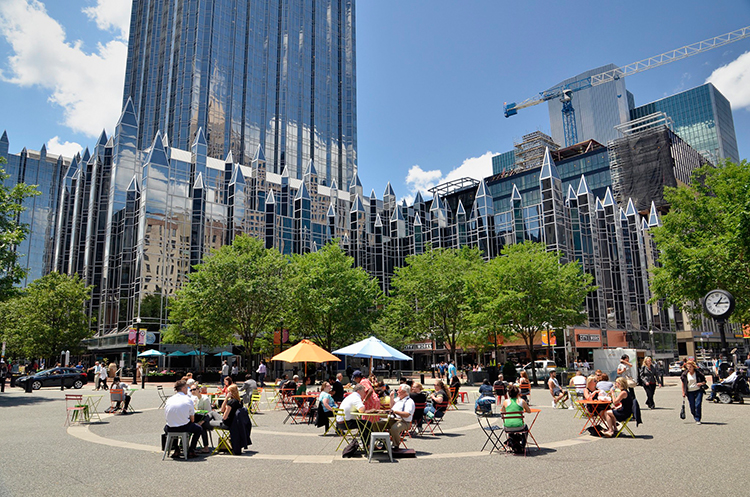
To be in a good place
with Kevin Bennett, Fellow at the Center for Urban Design and Mental Health
1. What motivated you to launch the Center for Urban Design and Mental Health?
In a broad sense, the Centre for Urban Design and Mental Health (UD/MH) is dedicated to bringing issues of mental health into the design of urban environments. This multidisciplinary approach includes psychologists, psychiatrists, urban planners, architects, geographers, engineers, policymakers, and anyone who would like to design better mental health into cities.
Historically, experts in urban planning and mental health have worked in their own separate camps with little interaction, however, UD/MH is working to fill this gap by building a synergistic connection between the two.
2. How would you describe the main goals of the Center for Urban Design and Mental Health?
The overarching goal is to design better mental health into cities. There already exists a good deal of information about how to accomplish this, but it is not being shared between mental health professionals, urban planners, and the policymakers who can implement these ideas. The goals for UD/MH include funding global multidisciplinary projects, providing resources for scholars to present research at conferences and other meetings, and sponsoring events that where professionals can gather to share information between cities.
3. Why is it important to address the nexus between Urban Design and Mental Health?
Many residents of urban areas around the world are able to enjoy the benefits of economic growth, developments in mass transit, and technological innovation. As a byproduct of this progress, however, densely populated metropolitan landscapes pose unique psychological challenges not found in other environments.
The connection between urbanicity and various aspects of mental health is well documented. This includes disorders with psychotic elements (e.g., schizophrenia) and non-psychotic elements (e.g., loneliness and depression). For example, greater levels of urbanicity, measured in overall population or density, are correlated with the incidence of schizophrenia. One study found that the risk for schizophrenia in the most urban environment is two times higher than in the most rural environment.
Recent research has explored potential mechanisms linking social exclusion in urban environments to psychosis. Evidence suggests that factors such as social fragmentation and deprivation may play a role. Also, a meta-analysis of psychiatric disorders in rural vs. urban environments within developed countries found higher rates of mood and anxiety disorders in urbanized areas.
It is important for designers and planners to be aware of these issues as they plan public and private spaces in the most densely crowded cities. Of course, urban design alone cannot solve mental health issues, but proper planning can be a key ingredient in minimizing mental health problems and maximizing quality of life for all citizens.

1. Pittsburgh’s Market Square is a public space in downtown that was modernized as social and cultural hub in the late 2000s. Source: Market Square in Pittsburgh, Pixabay.
4. What would you say are the features of contemporary urban design that have the strongest – positive or negative – impact on mental health? Today and historically?
We know that some environments can lead to the erosion of mental health, especially in situations where long periods of social and physical isolation are imposed on an individual. My colleagues and I recently published a study drawing upon sociology and criminal justice research that shows how the psychological consequences of modern urban design often parallel the effects found within solitary confinement in prisons. It seems that small, windowless rooms that confine people for long periods of time are generally not conducive to building self-esteem and life satisfaction—one could argue about its acceptability in prisons, but this is certainly not good for everyday urban dwellers.
On the positive side, I am very excited about new designs that incorporate social spaces and active spaces into the built environment. Social spaces are designed to motivate natural interactions among people. In some cases, it is as simple as installing more seating areas, including benches that face each other, to encourage social interaction. Research shows that people who live in neighborhoods with this kind of space have lower mental distress.
An active space is one that encourages exercise and mobility. The physical health benefits of walking, running, or biking are obvious, but there are also significant outcomes for mental health. For example, regular exercise can act in the same way antidepressants do in treating mild to moderate depression.

2. Social isolation is a growing issue with urban dwellers. Source: Isolation, Pixabay.
5. In your opinion, how can urban design be a variable that mitigates or aggravates the effects of the more social aspects of urban living on mental health?
Social isolation in cities is a growing epidemic. The percentage of American adults who say they are lonely has doubled since the 1980s from 20 percent to 40 percent. According to a recent survey, 52% of Londoners feel lonely. Cities provide an overwhelming sense of anxiety for many, driven in part by the dense crowds of anonymous strangers that constantly surround us. A large cross-cultural comparison of rural and urban areas in developed countries found that urban living raises the risk of mood disorders by 39%.
Urban design—no matter how well informed by behavioral health research—will not by itself solve the problem of mental illness. It is just one factor in a complicated mix of variables. That said, there are steps worth considering.
Out of all the solutions offered by psychologically informed urban design, I feel that mobility holds the most promise for meaningful change. As urban planners work to develop elements that promote physical health there is also an opening to fortify mental health. Designers should consider engineering schemes that inspire exercise during commutes, errands, and socializing. For instance, improving walkable spaces by widening pathways and making them safe areas. Because exercise begets more exercise, it follows that mobility will play a greater role in personal routines over time. This is good because regular physical activity has a positive impact on nearly every aspect of psychological well-being.
Central to this idea is the concept of “routine.” For people who are serious about achieving success in an area of self-improvement (e.g., weight management, memory performance, or relationship skills) one of the determining factors is consistency. It is very difficult to lose weight if you eat impetuously six days of the week. By the same token, “mobility as a routine” does not come easily if you only utilize mobility options once a week or less.

3. The fixed guideway transit system in Pittsburgh, known as ‘the incline’, moves one million commuters and tourists up and down Mt. Washington each year. Source: brandnewday, Pixabay.
6. Urban designers have often resorted to what is commonly termed as “hostile architecture”. How does this affect mental health in urban public spaces?
Hostile architecture elements—metal bars on benches or spikes on ledges—are specially designed exclude a certain section of a community from a public space. Essentially, they send out a message that is anathema to inclusive design. In many cases, they are effective enough in deterring homeless people which then validates the practice instead of addressing the underlying issue: Why are so many people homeless here? Plus, our cities end up looking very unfriendly and mildly barbaric.
7. How can practitioners and city dwellers be made more aware about the link between urban design and mental health?
The message that urban design can improve mental health is still unusual, and often does not feature in public health, architecture or urban planning dialogues. However, demographers estimate that between 1959 and 2042 the world population will grow from 3 billion to an estimated 9 billion. In contrast, the prior five million years of human history saw almost no significant population increases during any comparable span of time. We can also assume that in majority of the population will be living in cities-according to the World Bank since 2007 more than 50% of the world’s population lives in cities. This means that all of us will have no choice but to focus energy on the link between urban design and mental health. The key is that we start making changes now before it becomes an even greater challenge.
The Centre for Urban Design and Mental Health is working hard to reach new audiences by presenting research at conferences and engaging people about innovation and new approaches to promoting mental health. Other ways to make people aware include media appearances, classroom discussions, and popular science articles.
8. Has practitioners’ awareness, and attitude, towards urban design, changed over time? If so, what do you think has had the strongest impact?
In general, I see enthusiasm increasing even though the frequency of research collaborations between the two fields remains limited. As the volume of interdisciplinary work grows, so too will the awareness and appreciation for these new ideas. Part of the problem may stem from the fact that, unlike behavioral scientists, architects and urban planners do not conduct “research” in the sense that psychologists do, nor are they required to take any research methods courses as part of graduate school training. Conversely, urban design is not featured in most social science research methods courses.
I think we will see the most significant attitude changes whenever we are facing challenges that cannot be solved by urban designers or mental health practitioners alone. Classic research in social psychology tells us that one way to motivate attitude change and bring disparate groups together is to introduce superordinate goals. These are goals that require effort from members of both sides to be successful.
9. In what dimension of urban design do you think your work is more relevant and compelling?
Because my academic background is in social, personality, and evolutionary psychology I try to bring as much of this to the topic of urban design as possible. I describe my research focus as “psychological science at the intersection of urban design and mental health.” As a proponent of interdisciplinary collaborations, I am eager to share insights with researchers outside my area.
For example, the environment of evolutionary adaptatedness (EEA) refers to the ancestral environment to which a species is adapted. The modern world of today differs in many important respects from the EEA. The list of novelties offered by our modern world, but not present in the past includes agriculture, electricity, refrigeration, large scale weapons, medicines, mass communication, effective contraceptive devices, and virtually unlimited access to all types of proteins and carbohydrates. We are navigating our current world with psychological mechanisms designed to solve problems associated with survival and reproduction based past environments. Moving forward, what are the urban design implications of all this?
10. In conducting and reviewing research, what were some of the most striking findings on the relationship between Urban Design and mental health?
I am fascinated by the link between biophilic design and well-being. The research linking green spaces and mental health is compelling in part because it is anchored in evolved habitat preferences. Modern technology, structural designs, and construction materials allow us to comfortably inhabit climates that would have required intense effort just a few generations ago. Still, we carry with us the psychological preferences shaped by of generations of ancestors living in a much different world and often customize our environments to resemble that ancient habitat.
Most of us prefer physical spaces that offer views of green vistas over windowless basements. Looking at trees might even have a real health benefit. Studies of patients who viewed trees outside the window recovered more quickly from hospital stays. Also, bringing flowers increases optimism and actually improves the rate of recovery. The relationship between stress and uncultivated outdoor settings may play a role in this. When placed in uncertain and stressful situations, individuals who view pictures of nature scenery showed less physiological distress.
Contact with vegetation need not be active, such as gardening, to provide health benefits. Passively viewing vegetation through a window can produce desirable effects as well. Studies in biophilic design demonstrate that people living and working in spaces with vegetation compared to those without vegetation show improved performance on mental tasks, more positive moods, greater ability to re-focus attention, stress reduction, and diminished perceptions of pain in health care settings.
11. Based on the Center’s research, what would an ideal square look, feel and sound like?
For me, an ideal square would function as a social, inclusive, and safe space.
The Look: It’s a question of making public places more social, by, say, putting in more benches or setting up chessboards in a park or square.
The Feel: It should be open, inviting, and green where possible. Inclusive design is very important. Children, the elderly, and people with disabilities should be able to access the area safely. This is critical, whether it means security in terms of crime, traffic, or—for people with cognitive impairments—protection from getting lost. At the same time, the safe space should not feel sterile or smothering. Users should have choices about which route to take rather than being forced into one specific “safe” route.
The Sound: I would incorporate as many natural elements as possible. Water sounds are pleasing as long as the fountain or water feature is not over-sized, intrusive, or deafening. That is, art or water installations should serve as a gathering place, but not be so enormous it takes away from the available space for the community to come together comfortably.

4. Biophilic design: moving water, green elements, and a sense of space. Source: Phyo Hein Kyaw, Pexels.
12. What are the future goals of the Center for Urban Design and Mental Health?
The critical question posed by UD/MH is, “how can we build better mental health into our cities?” Four future goals help to address this question: Increase knowledge, motivate action, increase cross-sector discussion, and share knowledge. Recently, we created the city case study program that examines how different cities around the world apply the key principles of urban design towards population mental health. These case studies provide insight, spotlight innovation, identify opportunities for that city to improve population mental health, and offer lessons for other cities.
+
The images selected by Dr. Bennett to illustrate this interview are from Pittsburgh, Pennsylvania, where he lives and works.
Kevin Bennett, PhD, is a full teaching professor of psychology at The Pennsylvania State University, Beaver Campus and a fellow at the Centre for Urban Design and Mental Health. His research—psychological science at the intersection of urban design and mental health—explores social, personality, and evolutionary dimensions of human activity in the built environment. He is a regular contributor to Psychology Today and his work has appeared in the Chicago Tribune, Salon, Popular Science, Business Insider and many others. He has appeared on, or been featured in the New York Post, Sports Illustrated, China Global Television Network, and Talk Radio London on The Unexplained with Howard Hughes. Dr. Bennett earned his Ph.D. in Psychology from City, University of London and degrees from the University of New Mexico (M.S., Experimental Psychology) and the University of Michigan (B.A., Psychology).
www.urbandesignmentalhealth.com
Volume 3, No. 1 February 2020
